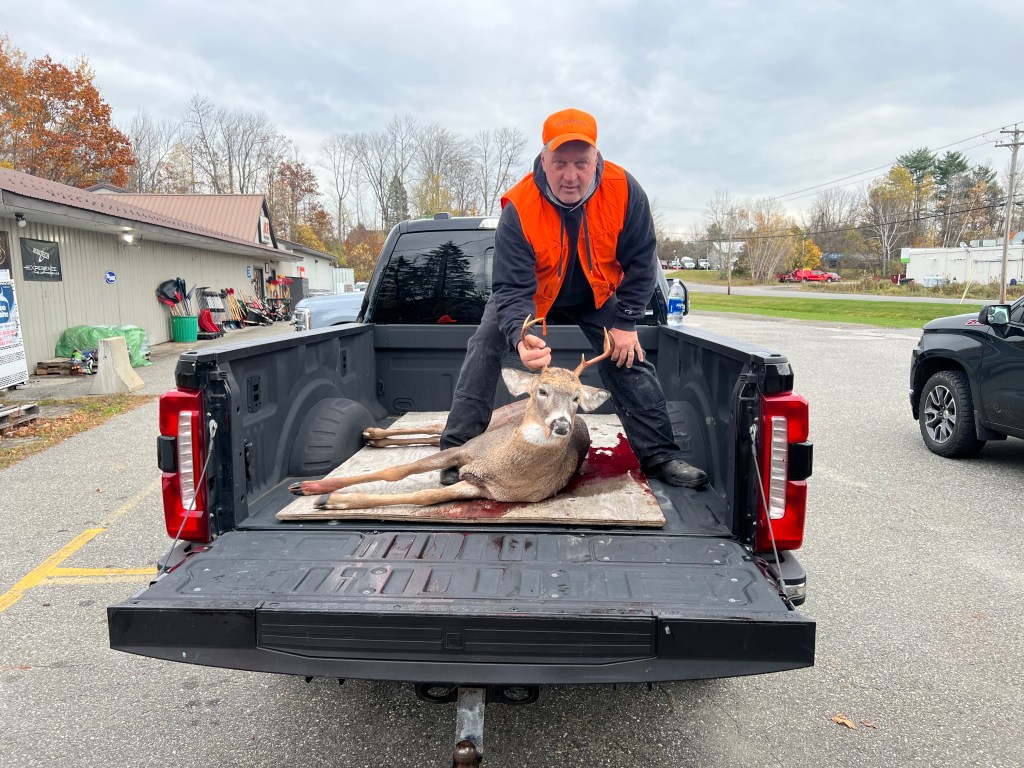Daniel Bell had never even heard of Mainers hunting for sport until he was an adult; in his family, hunting was always a food source. It was sustenance for the winter.
“If you’re thinking about going into a long winter in Maine — we all know that heating our houses can be difficult, and a lot of times, folks make a choice: ‘Do I buy heat, or do I buy food, or do I buy medication?'” Bell, the president of the Penobscot County Conservation Association and a recreational safety coordinator at the Maine Department of Inland Fisheries & Wildlife, said from his home in Holden last week.
“If they are hunters and they are hunting for food, then they have an easier choice to make, because they’re able to stock their freezers.”
Bob Ouellette was one of those hunters Saturday for the Mainers-only deer hunting day. He shot a 123-pounder, his second-ever deer, near his home in Winthrop around 7:30 a.m.

That amount of meat helps significantly in getting through the winter, he said.
“That’s not to say I won’t give some of it away, but it certainly helps a lot,” Ouellette said.
According to the U.S. Bureau of Labor Statistics, which tracks dozens of economic indicators, prices for meat, poultry, fish and eggs have increased by about 34% since January 2018 — an increase many Mainers simply can’t afford.
A family of four in Maine on a “survival budget” needs to spend a minimum of $933 per month on food, a 2023 study from United Way found. Costs to have deer meat processed range closer to $100–$150.
Now, with food-related benefits potentially lapsing for about 13% of Mainers and deer season opening this month, hunting could become an even more important source for rural Maine families.
Bell said, in his role at IF&W, he started to see an increase in people using deer hunting as a food source during the heat of the COVID-19 pandemic, when Mainers saw rapidly rising costs — but also had more time on their hands.
Changes to the deer permitting system — including allowing extra purchases of antlerless deer permits — has meant hunters can harvest more than one deer per season. As a result, many use the harvested venison as a primary protein source for even longer.
A 2022 IF&W survey showed a 10% increase in Mainers who hunted specifically for the meat, when compared to six years prior. More Mainers have sought deer hunting permits, especially after Maine revamped its permitting system in 2022 to allow hunters to take an antlerless deer in addition to an antlered deer.
Since 2015, deer harvesting in Maine has doubled, from just over 20,000 deer to well over 40,000. And on average, more deer have been taken per year this decade than at any point in the past century.
Bob Humphrey, a registered Maine guide and freelance writer who lives in Pownal, said he has also always thought of hunting as a means to fill his freezer for the winter.
Much of what Humphrey calls the “new guard” of hunting, though, didn’t get into hunting for that reason, he said. They went out into the woods inspired by reality television or social media or sport. He’s watched the number of new-guard hunters grow in the 51,000-member Facebook group he leads for deer hunters in Maine.
But as prices for food reach near-record levels, Humphrey said those newer hunters are increasingly seeing hunting the way he does: as a food source.
“People who were way outside the mainstream of the hunting world watch these shows,” Humphrey said. “Suddenly, not only is it OK, it’s cool to go out and get your own food.”
Harvested venison can often be leaner and healthier than store-bought meat, Bell said. And Humphrey said he thinks the health benefits go even further.
“It’s time spent outdoors, which people need a lot more of nowadays because they do a lot less,” Humphrey said. “It’s a chance to unwind when you go out and sit in the deer woods for four hours and you have nothing to think about but what’s around you. A lot of that other day-to-day stress just goes away.”

Bell said the shift in the thinking around hunting is here to stay. One child who joined IF&W’s mentorship program had the right idea from the start, he said.
“She made pictures, and it showed her shooting the deer with her bow and her arrow, and dragging the deer and bringing the deer home and putting it on her table,” Bell said. “That, in my mind, is a child that is perfect to teach these outdoor skills to. They’re in such a good frame of mind about it already because they view these animals as renewable resources — as food.”

We invite you to add your comments. We encourage a thoughtful exchange of ideas and information on this website. By joining the conversation, you are agreeing to our commenting policy and terms of use. More information is found on our FAQs. You can modify your screen name here.
Comments are managed by our staff during regular business hours Monday through Friday as well as limited hours on Saturday and Sunday. Comments held for moderation outside of those hours may take longer to approve.
Join the Conversation
Please sign into your CentralMaine.com account to participate in conversations below. If you do not have an account, you can register or subscribe. Questions? Please see our FAQs.